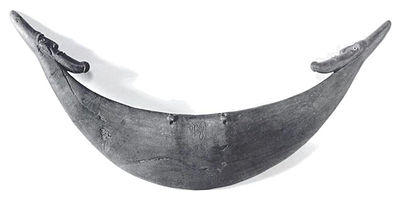
Rongorongo text J
Encyclopedia

Rongorongo
Rongorongo is a system of glyphs discovered in the 19th century on Easter Island that appears to be writing or proto-writing. It cannot be read despite numerous attempts at decipherment. Although some calendrical and what might prove to be genealogical information has been identified, not even...
corpus, also known as (London) reimiro 1, is the larger of two inscribed reimiro
Reimiro
A reimiro is a decorative crescent-shaped pectoral ornament once worn by the women of Easter Island. The name comes from the Rapanui rei 'stern' or 'prow' and miro 'boat'. Thus the crescent represents a Polynesian canoe....
in London and one of two dozen surviving rongorongo texts.
Other names
J is the standard designation, from BarthelThomas Barthel
Thomas Sylvester Barthel was a German ethnologist and epigrapher who is best known for cataloguing the undeciphered rongorongo script of Easter Island....
(1958). Fischer (1997) refers to it as RR20.
Physical description
A prototypical two-headed Rapanui reimiro, or ceremonial crescent-shaped gorgetGorget
A gorget originally was a steel or leather collar designed to protect the throat. It was a feature of older types of armour and intended to protect against swords and other non-projectile weapons...
/epaulet, 73 × 13.2 cm, of unknown wood. There are a few worm trails, but it is in excellent condition. The two holes top center were used to hang it from clothing.
Two glyphs are cut into the top center of the front, between the two holes used to hang it.
Provenance
The British Museum catalog states:- Presented by [Augustus] W. Franks Esq. Aug. 2. 1870. Obtained by Dr Comrie from the master of a vessel which brought it from Easter Island.
A label on the back reads:
- 6847. Easter Id. Pres. by A. W. Franks Esq. 8.8.70. Comrie [Collection].
Fischer says that the phrase "the master of a vessel" suggests that it was acquired before the Chilean slaving raids of 1862-63, probably during the 1820s to 1840s, the most active whaling period
History of whaling
The history of whaling is very extensive, stretching back for millennia. This article discusses the history of whaling up to the commencement of the International Whaling Commission moratorium on commercial whaling in 1986....
in the South Pacific.
Inscribed reimiro were evidently rare: An elder told Routledge that he had never seen a reimiro with glyphs.
Despite its poor provenance, there are no doubts as to its authenticity.
Text


The second glyph is "clearly" a rapa, or ceremonial dance paddle. It appears to be held by a human figure, glyph 530
 , with what might be a headdress.
, with what might be a headdress.


